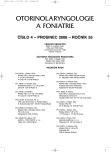The Standpoint of the Monitoring Specialist on Preservation of Facial Nerve Function in Removing of Vestibular Schwannoma by Translabyrinth Approach
Authors:
L. Kaliarik; S. Krempaská; J. Kovaľ
Authors‘ workplace:
Klinika otorinolaryngológie a chirurgie hlavy a krku LF UPJŠ a FNLP, Košice
prednosta prof. MUDr. J. Kovaľ, CSc.
Published in:
Otorinolaryngol Foniatr, 55, 2006, No. 4, pp. 206-212.
Category:
Original Article
Overview
The authors describe in detail the technique of preoperative monitoring of n.VII in removing a vestibular schwannoma by translabyrinth approach. The method has been used in 57 patients. The authors point out the teamwork of the surgeon and the monitoring specialist based on continuous preoperative communication. At the same time they make an effort to forecast postoperative function of facial nerve on the basis of evoked electromyography. It has become apparent that only the response (although small) evoked by the stimulation at the output of facial nerve from the brain stem at the intensity of 0.05-0.1mA may be considered as a good prognostic index of early as well as late postoperative function of facial nerve – HB I, II, III. An uncertain of response after the stimulation of 0.3mA or more in the region of the output of n.VII from the brain stem is the index of poor early or late postoperative function of facial nerve – HB IV-V. The perioperative monitoring of n.VII is considered to be a significant method improving the comfort of the surgeon, improving orientation in the operation field and, in addition to surgical experience, contributes significantly to achieve good functional results for facial nerve. Moreover, in combination of video-recording the monitoring of n.VII provides significant educational resources for improving surgical technique. This method has not been proved so far as a reliable tool for the determination of poor perspective of facial nerve function in that the stimulation and response could provide with certainty a poor postoperative function with anatomically preserved nerve, which would make it possible to indicate, in the course of operation, splitting of the anatomically preserved nerve, which lacks the perspective of adjustment into the HB stage I, II, III, and IV.
Key words:
perioperative monitoring of facial nerve, postoperative function of n.VII, vestibular schwannoma, translabyrinth approach.
Labels
Audiology Paediatric ENT ENT (Otorhinolaryngology)Article was published in
Otorhinolaryngology and Phoniatrics

2006 Issue 4
Most read in this issue
- Traumatic Perforation of Eardrum
- Herpes Zoster Oticus
- Clinical Anatomy of the Epitympanum
- Possibilities of 24-hour pH-metry of Upper Esophagus in the Diagnostics of Esophageal-Pharyngeal Reflux
